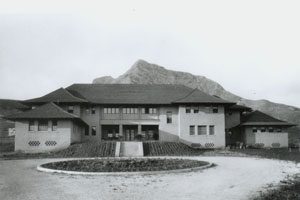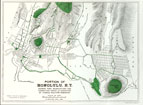Demonstration Papers: The Girls' Industrial School
In the examination of the history of Hawai'i's Girls' Industrial School (GIS) during a portion of the territorial period, roughly 1916 to 1934, we encounter several themes that are both critical to this period and under-examined in historical works of the Territorial period in Hawai'i. One theme is the expanding opportunities for women to carve out professional careers for themselves as superintendents at women's prisons, reformatories, and industrial schools. Another, more obvious one, has been explored in detail in many feminist histories: women of one class assisting, through active instruction and example, in the uplift of girls and young women who were believed to be as much victims of their environments, and their families, as well as their personal waywardness.

A third theme is how Hawai'i's racial, ethnic, and cultural differences and distinctions are so starkly reflected in the composition of the staff and inmates of GIS. All those in charge were Caucasian (Haole); nearly to a girl, all those housed at the GIS (which later became the Maunawili Girls' Training School and then the Kawailoa Girls' Training School) were not. For example, according to the statistics provided in the annual and then biennial reports for the Girls' Schools for the period covering 1916-1934, the Hawaiian and part-Hawaiian portion of the population was never less than 44.8% and was as high as 68.5% during an eighteen month period in 1929-30. Considering that the total Hawaiian and part-Hawaiian population for the Territory during these years ran about 14% of the total population, the number of Hawaiian girls sent to GIS due to their "dependency" or "delinquency" speaks to the inordinate pressures that the Hawaiian population was experiencing. Such evidence suggests, too, that colonization more likely wore the face of Americanization during this and subsequent periods.

Although a short history of the Boys' Industrial School exists (Myron B. Thompson's M.S.W. thesis, August 1955), no systematic study of the Girls' School has been done. Thus this project on the Girls' Industrial School presents a wealth of primary documents to probe: the annual and biennial Industrial Schools reports and the annual Governor's Reports (found at UHM's Hamilton Library, Hawaiian Pacific Collection and the State Archives); the minutes of the monthly meetings of the Board of Commissioners for the Industrial Schools (housed at the Hawai'i State Archives); photographs of some of the girls taken by Louis R. Sullivan, 1920-21 (in the Bishop Museum photographic archives); items about the Schools in the Honolulu Advertiser and Star-Bulletin. In addition, one could consult other institutions' records &endash; the Kalihi Orphanage, Waimano Home, Salvation Army Women's Home, Kawaihao Church, Central Union Church, Queen's Hospital, Palama Settlement, the Y.W.C.A., etc. &endash; for references to GIS. Finally, the Hawaiian language newspapers might allow us to hear what the Hawaiian community, from which so many of the girls came, had to say about the Girls' Industrial School.
